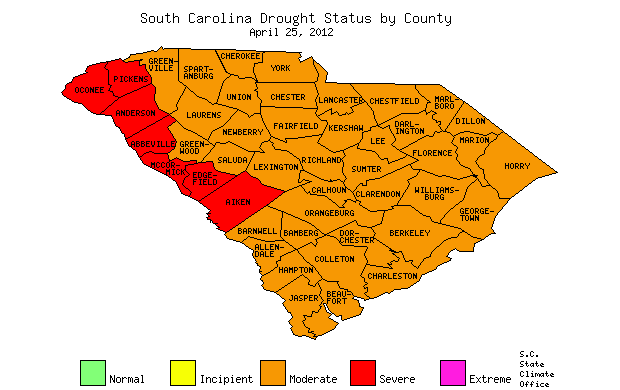

For previously issued drought statements see the archived status reports.
Table of all counties and drought status.Members of the S.C. Drought Response Committee, meeting via tele-conference on April 25, maintained the drought status statewide for all counties except Aiken, which was upgraded to Severe. Aiken was added to the list of six counties (Oconee, Pickens, Anderson, Abbeville, McCormick and Edgefield) in the Savannah River Basin designated at severe, the third level of drought. All other counties in the state remain at moderate drought status.
The Savannah Basin continues to be one of the hardest hit regions from the continuing drought. Aiken was brought into the "Severe" drought level based on support from all indicators that the drought was deteriorating in the central Savannah region.
Jason Ward from the U.S. Army Corps of Engineers Savannah District reported, "The Savannah River Projects are in Level 2 Drought based on their Drought Contingency Plan, however, they have been trying to proactively conserve water by lowering their target release at Lake Thurmond to 3,800 cubic feet per second (CFS). Projected lake elevations are three feet above Level 3 by early July unless the rainfall outlooks significantly improve."
According to Hope Mizzell, S.C. State Climatologist, the winter and early spring have been dry with most locations receiving less than 65 percent of normal rainfall, "Rainfall during this time of year is crucial for adequate recharge which did not occur. As we move into late spring and summer it takes normal rainfall just to keep up with evapo-transpiration and increased water demand."
Scott Harder, S.C. Department of Natural Resources (DNR) Hydrologist, confirmed that generally there was not sufficient recharge and well levels are less than 25 percent of normal for parts of the state, "The Savannah Basin lakes have been the hardest hit with lake levels in Hartwell and Thurmond ranging seven to eight feet below target for this time of year. Jocassee is over 20 feet below target. Other lakes such as Murray, Wateree and Moultrie are close to or at their target storage. Streamflow levels are also running below to much below normal flows for this time of year."
Eric Odom, City of Orangeburg Water Division Director, added that in February and March, they experienced record low stream flows along the North Fork Edisto River, but from a water supply standpoint, they currently have plenty of water available. He stressed they will continue to monitor stream flows as they approach the summer months.
Mike Caston, Startex-Jackson-Wellford-Duncan Water District Executive Director, stressed, "While I agree with maintaining the current drought status as 'Moderate' in the Central Drought response region, it is worth noting that low stream flows and low groundwater levels cause me great concern. We (SJWD) have experienced a dry winter and if the spring and summer continue this trend, the situation could turn much worse in a hurry. Our utility, and I know other utilities also, have observed lower water demands and these lower demands have been a trend over the last three or four years. This has been helpful during this period of drought and will be even more important if the drought continues. The slower economy has probably contributed to these lower demands, but most of the credit goes to consumers who have answered the call to be better stewards of our water resources and they should be applauded. Wise management and use of our water resources is not only the right thing to do, but paramount in times of drought."
Drought Response Committee Chairman Ken Rentiers stated, "The Committee will continue to monitor the situation closely and reconvene in approximately four weeks or sooner as needed."
DNR protects and manages South Carolina's natural resources by making wise and balanced decisions for the benefit of the state's #natural resources and its people. Find out more about DNR at the DNR Web site.
| Current Drought Status by County | ||||
|---|---|---|---|---|
| Normal | Incipient | Moderate | Severe | Extreme |
| County Status |
County Status |
County Status |
County Status |
County Status |
| ABBEVILLE Severe |
AIKEN Severe |
ALLENDALE Moderate |
ANDERSON Severe |
BAMBERG Moderate |
| BARNWELL Moderate |
BEAUFORT Moderate |
BERKELEY Moderate |
CALHOUN Moderate |
CHARLESTON Moderate |
| CHEROKEE Moderate |
CHESTER Moderate |
CHESTERFIELD Moderate |
CLARENDON Moderate |
COLLETON Moderate |
| DARLINGTON Moderate |
DILLON Moderate |
DORCHESTER Moderate |
EDGEFIELD Severe |
FAIRFIELD Moderate |
| FLORENCE Moderate |
GEORGETOWN Moderate |
GREENVILLE Moderate |
GREENWOOD Moderate |
HAMPTON Moderate |
| HORRY Moderate |
JASPER Moderate |
KERSHAW Moderate |
LANCASTER Moderate |
LAURENS Moderate |
| LEE Moderate |
LEXINGTON Moderate |
MARION Moderate |
MARLBORO Moderate |
MCCORMICK Severe |
| NEWBERRY Moderate |
OCONEE Severe |
ORANGEBURG Moderate |
PICKENS Severe |
RICHLAND Moderate |
| SALUDA Moderate |
SPARTANBURG Moderate |
SUMTER Moderate |
UNION Moderate |
WILLIAMSBURG Moderate |
| YORK Moderate |
||||
| SC Drought Response Committee Meeting, April 25, 2012 Sign-In sheet | |
|---|---|
| Name & Agency | Name & Agency |
Find out more about the State Climatology Office at https://www.dnr.sc.gov/climate/sco/ or by calling (803) 734-9100.
